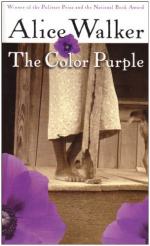|
This section contains 297 words (approx. 1 page at 400 words per page) |

|
The Color Purple Summary & Study Guide Description
The Color Purple Summary & Study Guide includes comprehensive information and analysis to help you understand the book. This study guide contains the following sections:
This detailed literature summary also contains Bibliography and a Free Quiz on The Color Purple by Alice Walker.
The Color Purple, Alice Walker's third novel, was published in 1982. The novel brought fame and financial success to its author. It also won her considerable praise and much criticism for its controversial themes. Many reviewers were disturbed by her portrayal of black males, which they found unduly negative. When the novel was made into a film in 1985 by Steven Spielberg, Walker became even more successful and controversial. While she was criticized for negative portrayal of her male characters, Walker was admired for her powerful portraits of black women. Reviewers praised her for her use of the epistolary form, in which written correspondence between characters comprises the content of the book, and her ability to use black folk English. Reflecting her early political interests as a civil rights worker during the 1960s, many of her social views are expressed in the novel. In The Color Purple, as in her other writings, Walker focuses on the theme of double repression of black women in the American experience. Walker contends that black women suffer from discrimination by the white community, and from a second repression from black males, who impose the double standard of white society on women. As the civil rights movement helped shape Ms. Walker's thinking regarding racial issues at home, it also shaped her interest in Africa. During the 1960s, a strong interest in ethnic and racial identity stimulated many African Americans to look for their roots in Africa. The primary theme of The Color Purple, though, reflects Walker's desire to project a positive outcome in life, even under the harshest conditions. Her central character triumphs over adversity and forgives those who oppressed her. This central theme of the triumph of good over evil is no doubt the source of the book' s great success.
Read more from the Study Guide
|
This section contains 297 words (approx. 1 page at 400 words per page) |

|



